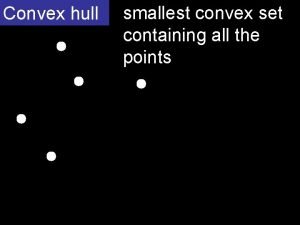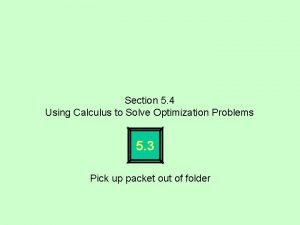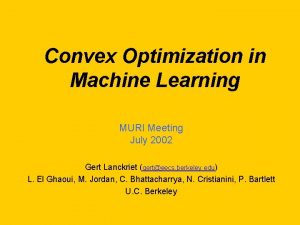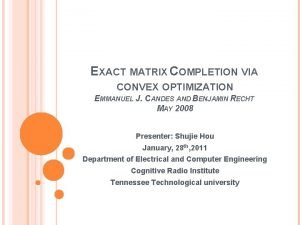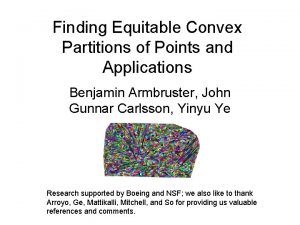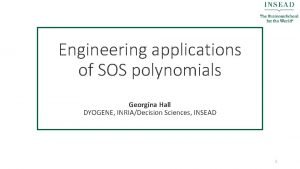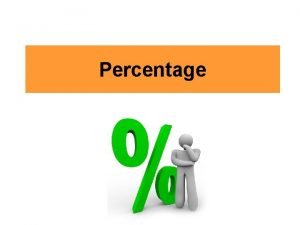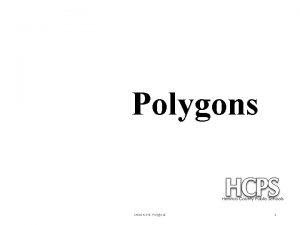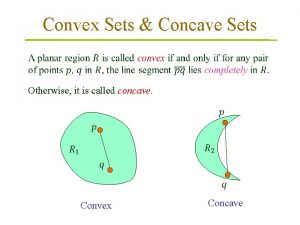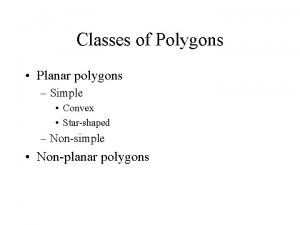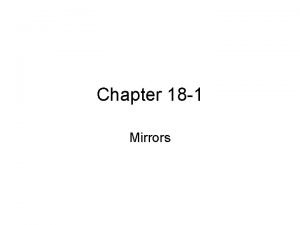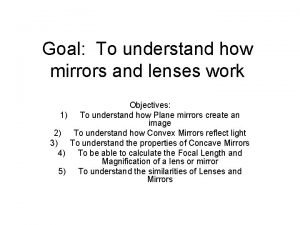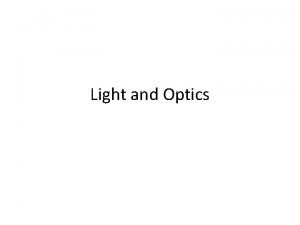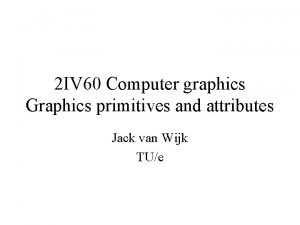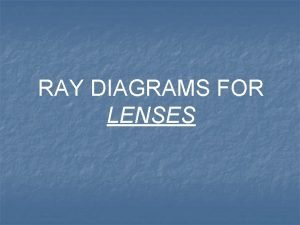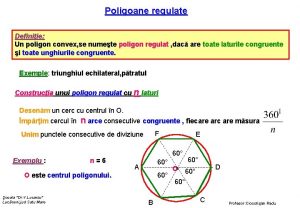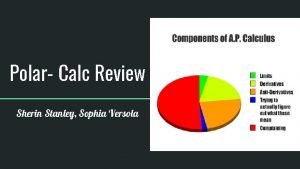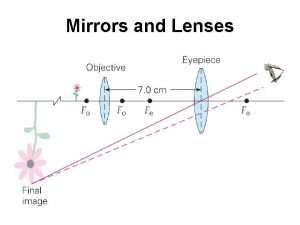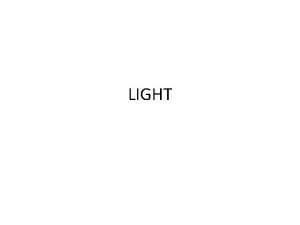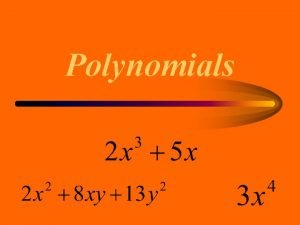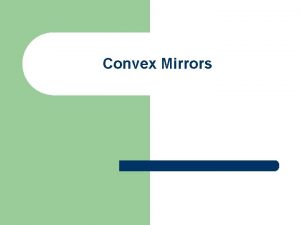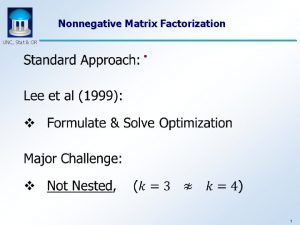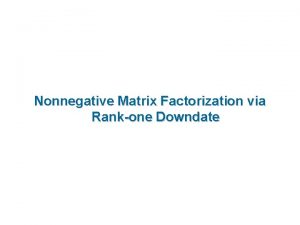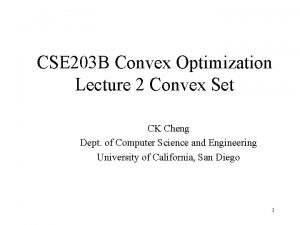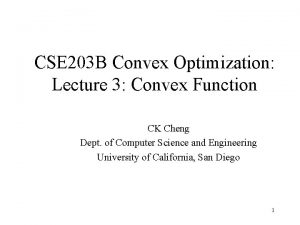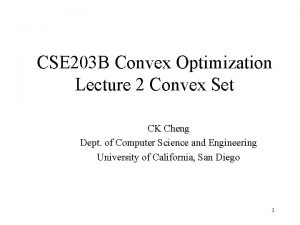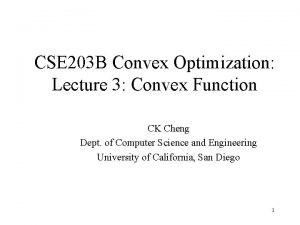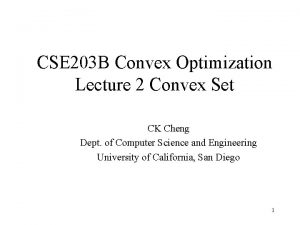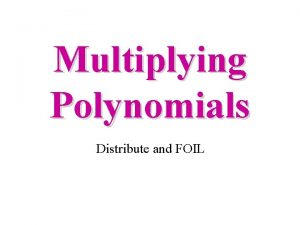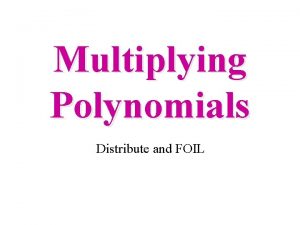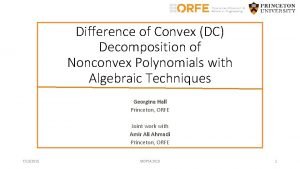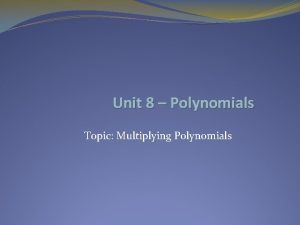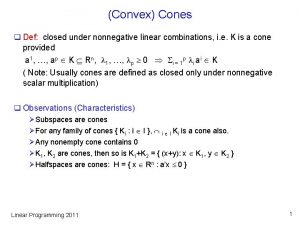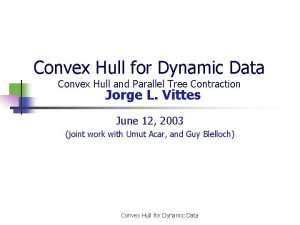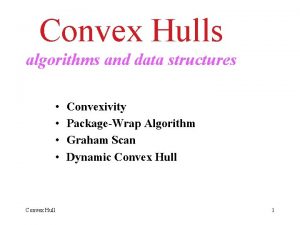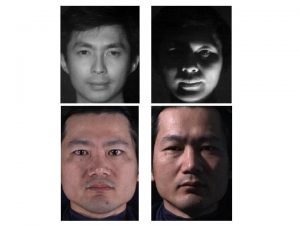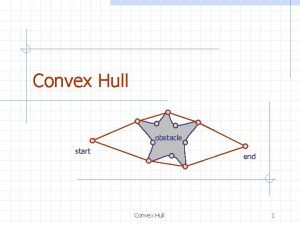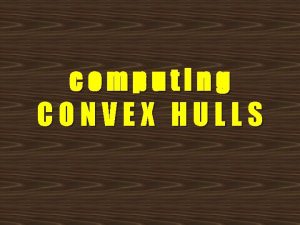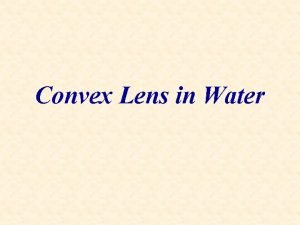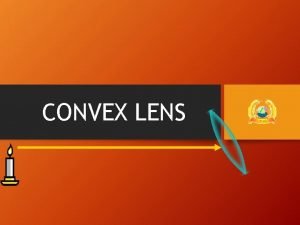Nonnegative polynomials and difference of convex optimization Georgina



































- Slides: 35

Nonnegative polynomials and difference of convex optimization Georgina Hall Princeton, ORFE Joint work with Amir Ali Ahmadi Princeton, ORFE 2/20/2021 IBM May 2016 1

Nonnegative and convex polynomials • Is this polynomial nonnegative?

Optimizing over nonnegative polynomials Polynomial optimization: Option pricing with moment information Optimal power flow problem Automated search for Lyapunov functions for dynamical systems

Optimizing over nonnegative polynomials Includes certificates of optimality in discrete optimization problems Example: independent set of graph G=(V, E)

Optimizing over convex polynomials • Convex fitting Convex envelope approximation

Imposing nonnegativity or convexity •

Imposing nonnegativity or convexity • Example:

This talk • Recent efforts to make sos more scalable by avoiding SDP (Ahmadi, Dash, Majumdar) • Using more scalable versions of sum of squares for difference of convex programming

Alternatives to sums-of-squares: dsos and sdsos Sum of squares (sos) SDP Diagonally dominant sum of squares (dsos) LP Scaled diagonally dominant sum of squares (sdsos) SOCP Ahmadi, Majumdar

Alternatives to sums-of-squares: dsos and sdsos intractable scalability How much do we lose? How to improve? Idea: Iteratively construct a sequence of improving LP/SOCP-based cones

Cholesky change of basis (1/3) dd in the “right basis” psd but not dd

Cholesky change of basis (2/3) Step 2 Step 1 Initialize Another recent technique: Column Generation method with Sanjeeb Dash.

Cholesky change of basis (3/3) • Example: stability number of the Petersen graph

This talk • Recent efforts to make sos more scalable by avoiding SDP (Ahmadi, Dash, Majumdar) • Using more scalable versions of sum of squares for difference of convex programming

Difference of Convex (DC) programming • Applications: Machine Learning (Sparse PCA, Kernel selection, feature selection in SVM) Hiriart-Urruty, 1985 Tuy, 1995 15

Difference of Convex (dc) decomposition •

Existence of dc decomposition (1/5) Recall: SOS-convexity Theorem: Any polynomial can be written as the difference of two sos-convex polynomials. Corollary: Any polynomial can be written as the difference of two convex polynomials.

Existence of dc decomposition (2/5) • K E 18

Existence of dc decomposition (3/5) • solving is an SDP.

Existence of dc decomposition (4/5) DSOS-convexity SDSOS-convexity For scalability Theorem: Any polynomial can be written as the difference of two dsos-convex polynomials.

Existence of dc decomposition (5/5) •

Uniqueness of dc decomposition • Initial decomposition Yes Through s/d/sos-convexity Alternative decompositions “Best decomposition? ”

Convex-Concave Procedure (CCP) • Heuristic for minimizing DC programming problems. • Idea: Input Solve convex subproblem convex affine 23

Convex-Concave Procedure (CCP) • Reiterate 24

Picking the “best” decomposition for CCP (1/3) Algorithm Idea Mathematical translation Average curvature* Worst-case curvature* 25

Picking the “best” decomposition for CCP (2/3) DOMINATED BY 26

Picking the “best” decomposition for CCP (3/3) • 27

Comparing different decompositions (1/2) • Feasibility Undominated 28

Comparing different decompositions (2/2) • Average over 30 iterations • Solver: Mosek • Computer: 8 Gb RAM, 2. 40 GHz processor Feasibility Undominated Conclusion: Rate of convergence of CCP strongly affected by initial decomposition. 29

Comparing the different relaxations (1/2) • Type of relaxation Time Opt value dsos-convex <1 s 62090 <1 s sdsos-convex <1 s 53557 sos-convex <1 s 11602 Time Opt Value Time Opt value 168481 2. 33 s 136427 6. 91 s 48457 1. 11 s 132376 3. 89 s 99667 12. 16 s 32875 44. 42 s 18346 800. 16 s 9828 30 hrs+ ------30

Comparing the different relaxations (2/2) sos-convex + CCP sdsos-convex + multiple decomposition CCP Solve convex subproblem Convexify 1000000 0 Convexify Solve convex subproblem -1000000 -2000000 -3000000 -4000000 -5000000 -6000000 -7000000 • Unconstrained problem with objective of degree 4 • Objective value after 4 mins • Average over 30 instances -8000000 -9000000 31

Main messages • Optimizing over nonnegative and convex polynomials has many applications. • Sum of squares techniques used are SDPs (expensive). • More scalable versions of sum of squares are presented (DSOS, SDSOS, Cholesky Basis method). • Applied these techniques to DCP, to decompose a polynomial into a difference of convex functions. The choice of the decomposition impacts speed of convergence of CCP.

Thank you for listening Questions? Want to learn more? http: //scholar. princeton. edu/ghall/home 33

Existence of difference of convex decomposition (1/4) • How to get round this? SOS-convexity Theorem: Any polynomial can be written as the difference of two sos-convex polynomials.

Difference of Convex (DC) programming (2/2) • Kernel selection Feature selection in SVM 35
 Convex polygons examples
Convex polygons examples Convex hull is the smallest convex set
Convex hull is the smallest convex set The sum of two nonnegative numbers is 20
The sum of two nonnegative numbers is 20 Convex optimization in machine learning javatpoint
Convex optimization in machine learning javatpoint Exact matrix completion via convex optimization
Exact matrix completion via convex optimization Convex optimization
Convex optimization Georgina collins
Georgina collins Lisa rowe monologue
Lisa rowe monologue Best ice cream wheatley
Best ice cream wheatley Georgina holden
Georgina holden The cruise-control function on georgina's car
The cruise-control function on georgina's car Georgina lock
Georgina lock Georgina krüger
Georgina krüger The pre-raphaelite brotherhood zanichelli
The pre-raphaelite brotherhood zanichelli Georgina gough
Georgina gough Georgina hall insead
Georgina hall insead Georgina newton
Georgina newton 180 degree angle
180 degree angle Concave and convex polygon definition
Concave and convex polygon definition Covex and concave
Covex and concave Hipermetropy
Hipermetropy Concave sets
Concave sets Planar polygons
Planar polygons Is flat, smooth mirror
Is flat, smooth mirror Concave and convex mirror
Concave and convex mirror How to find the height of an image in a convex mirror
How to find the height of an image in a convex mirror Convex and concave polygon in computer graphics
Convex and concave polygon in computer graphics Weld mapping symbols
Weld mapping symbols Convex limacon
Convex limacon Converging lens
Converging lens Poligoane regulate formule
Poligoane regulate formule Flat limacon
Flat limacon Convex vs concave teeth
Convex vs concave teeth A light ray traveling obliquely to a convex mirror axis
A light ray traveling obliquely to a convex mirror axis Concave vs convex light refraction
Concave vs convex light refraction Imaging rules for concave mirrors
Imaging rules for concave mirrors

